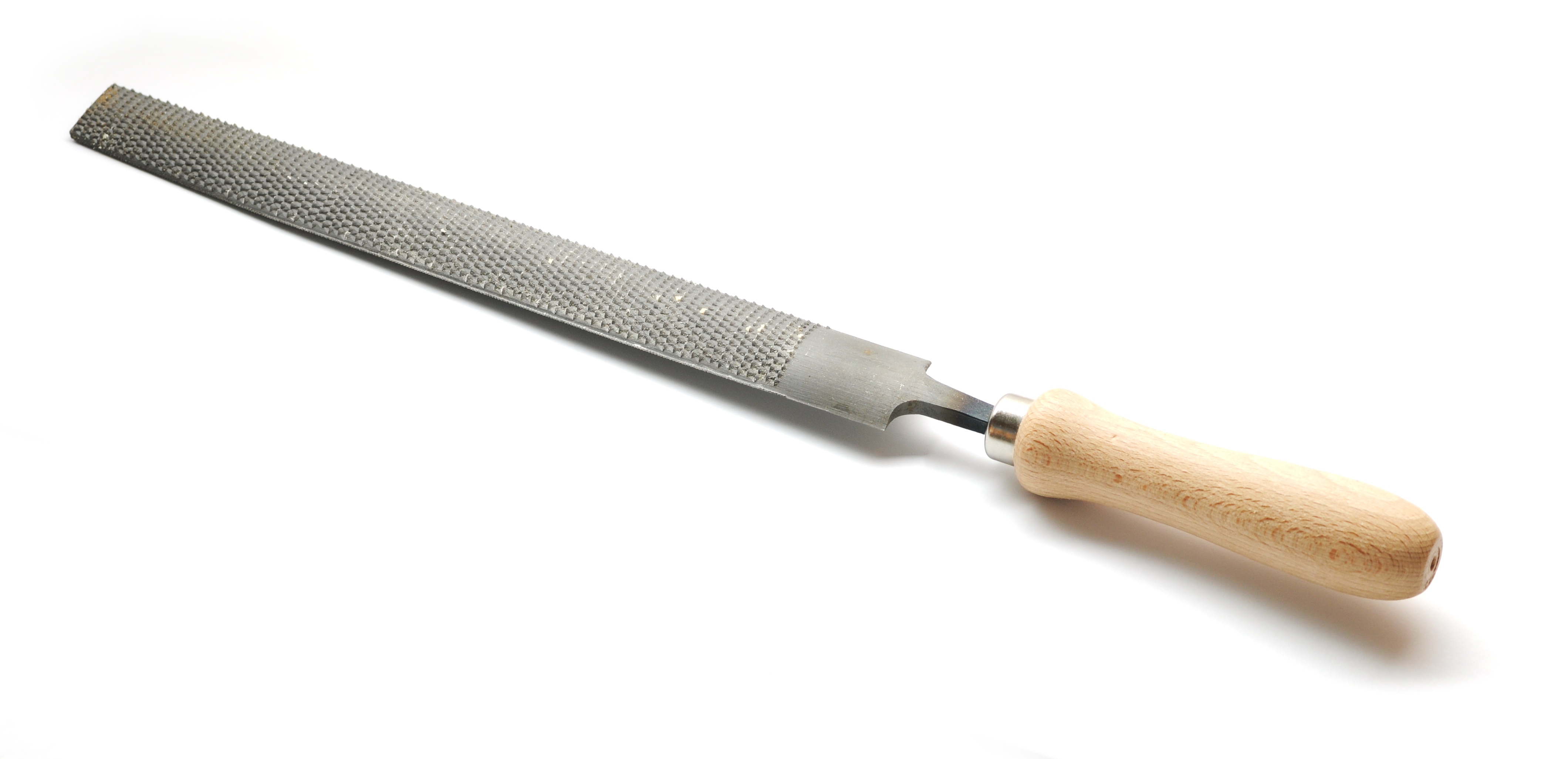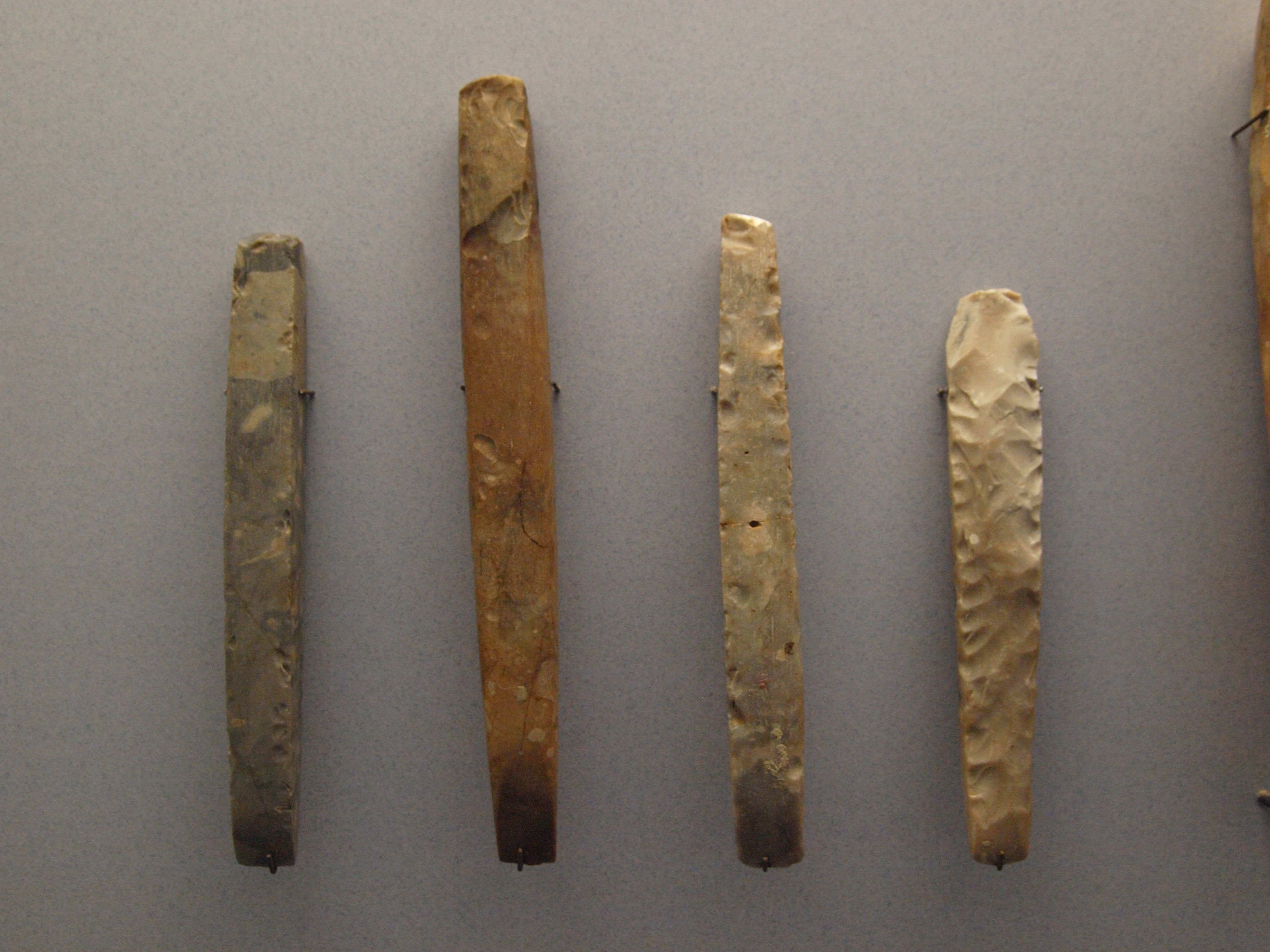|
Rasp
A rasp is a coarse form of file used for shaping wood, metal, or other material. Typically a hand tool, it consists of a generally tapered rectangular, round, or half-round sectioned bar of case hardened steel with distinct, individually cut teeth. A narrow, pointed tang is common at one end, to which a handle may be fitted. Uses Rasps come in a variety of shapes—rectangular, round, and half-round—and vary in coarseness, from finest, "cabinet", to most coarse, "wood". Farriers, for example, commonly use rasps to remove excess wall from a horse's hoof. They are also used in woodworking for rapidly removing material and are easier to control than a drawknife. The rough surfaces they leave may be smoothed with finer tools, such as single- or double-cut files. Rasps are used in shaping alabaster. Saws and chisel A chisel is a hand tool with a characteristic Wedge, wedge-shaped cutting edge on the end of its blade. A chisel is useful for carving or cutting a h ... [...More Info...] [...Related Items...] OR: [Wikipedia] [Google] [Baidu] |
Farrier
A farrier is a specialist in equine hoof care, including the trimming and balancing of horses' hooves and the placing of shoes on their hooves, if necessary. A farrier combines some blacksmith's skills (fabricating, adapting, and adjusting metal shoes) with some veterinarian's skills (knowledge of the anatomy and physiology of the lower limb) to care for horses' feet. Traditionally an occupation for men, in a number of countries women have now become farriers. History While the practice of putting protective hoof coverings on horses dates back to the first century, evidence suggests that the practice of nailing iron shoes into a horse's hoof is a much later invention. One of the first archaeological discoveries of an iron horseshoe was found in the tomb of Merovingian king Childeric I, who reigned from 458 to 481 or 482. The discovery was made by Adrien Quinquin in 1653, and the findings were written about by Jean-Jacques Chifflet in 1655. Chifflet wrote that the iro ... [...More Info...] [...Related Items...] OR: [Wikipedia] [Google] [Baidu] |
Woodworking
Woodworking is the skill of making items from wood, and includes cabinetry, furniture making, wood carving, joinery, carpentry, and woodturning. History Along with stone, clay and animal parts, wood was one of the first materials worked by early humans. Microwear analysis of the Mousterian stone tools used by the Neanderthals show that many were used to work wood. The development of civilization was closely tied to the development of increasingly greater degrees of skill in working these materials. Among the earlliest finds of woodworking are shaped sticks displaying notches from Kalambo Falls in southen Africa, dating to around 476,000 years ago. The Clacton spearhead from Clacton-on-Sea, England, dating to around 400,000 years ago,Allington-Jones, L., (2015) ''Archaeological Journal'', 172 (2) 273–296 The Clacton Spear – The Last One Hundred Years the Schöningen spears, from Schöningen (Germany) dating around 300,000 years ago and the Lehringen spear from no ... [...More Info...] [...Related Items...] OR: [Wikipedia] [Google] [Baidu] |
Tang (tools)
A tang or shank is the back portion of the blade component of a tool where it extends into stock material or connects to a handle – as on a knife, sword A sword is an edged and bladed weapons, edged, bladed weapon intended for manual cutting or thrusting. Its blade, longer than a knife or dagger, is attached to a hilt and can be straight or curved. A thrusting sword tends to have a straighter ..., spear, arrowhead, chisel, file, coulter, pike, scythe, screwdriver, etc. One can classify various tang designs by their appearance, by the manner in which they attach to a handle, and by their length in relation to the handle. ''Nakago'' is the term in Japanese, used especially when referring to the tang of the katana or the wakizashi. Full vs partial tang A full tang extends the full length of the grip-portion of a handle, versus a ''partial'' tang which does not. A full tang may or may not be as wide as the handle itself, but will still run the full length of ... [...More Info...] [...Related Items...] OR: [Wikipedia] [Google] [Baidu] |
Surform
A surform tool (also surface-forming tool) features Perforation, perforated sheet metal and resembles a food grater. A surform tool consists of a steel strip with holes punched out and the rim of each hole sharpened to form a blade, cutting edge. The strip is mounted in a carriage or handle. Surform tools were called "cheese graters" decades before they entered the market as kitchen utensils used to grate cheese. Surform planes have been described as a cross between a rasp and a Plane (tool), plane. Although similar to many food graters made of perforated sheet metal, surforms differ in having sharpened rims. Also, a surform typically is used to shape material, rather than grate it. Etymology and history The word ''surform'' is an apparent portmanteau of "surface" and "form". It is unclear whether this is a genericized trademark or the opposite, a common name that was subsequently trademarked. Surform is a registered trademark of Stanley Black & Decker, Inc. in many countries ... [...More Info...] [...Related Items...] OR: [Wikipedia] [Google] [Baidu] |
Metalworking Hand Tool
Metalworking hand tools are Hand tool, hand tools used in the metalworking field. Types Dollies Dolly (tool), Dollies can be handheld, or mounted on a stake or post. Metal dollies come in a variety of sizes and shapes and are used for all types of hand-forming, planishing (smoothing), and shrinking. Files and rasps File (tool), Files and Rasp, rasps are used to provide a smooth Surface finishing, finish for detail work, and are often used in the Aerospace manufacturer, aerospace industry. Forming bags Forming bags, also known as ''soft dollies'', are usually filled with sand or lead, shot and sewn very tightly out of a top-grade canvas or leather. When used correctly, a forming bag allows the user to "shrink" the metal without marking it. Hammers A wide range of body Hammer, hammers are used in metalworking. Hammers range from small, lightweight "pick" hammers (which provide stubby pick point and high-crown peen-type faces that will ding out small dents in hig ... [...More Info...] [...Related Items...] OR: [Wikipedia] [Google] [Baidu] |
File (tool)
A file is a tool used to remove fine amounts of material from a workpiece. It is common in woodworking, metalworking, and other similar trade and hobby tasks. Most are hand tools, made of a case hardened steel bar of rectangular, square, triangular, or round cross-section, with one or more surfaces cut with sharp, generally parallel Tine (structural), teeth. A narrow, pointed Tang (tools), tang is common at one end, to which a handle may be fitted.. A rasp is a form of file with distinct, individually cut teeth used for coarsely removing large amounts of material. Files have also been developed with abrasive surfaces, such as natural or synthetic diamond tool, diamond grains or silicon carbide, allowing removal of material that would dull or resist steel files, such as ceramic. History Early filing or rasping has prehistoric roots and grew naturally out of the blending of the twin inspirations of cutting with stone cutting tools (such as hand axes) and abrasive, abrading u ... [...More Info...] [...Related Items...] OR: [Wikipedia] [Google] [Baidu] |
Horse Hoof
A horse hoof is the lower extremity of each leg of a horse, the part that makes contact with the ground and carries the weight of the animal. It is both hard and flexible. It is a complex structure surrounding the distal Phalanx bones, phalanx of the 3rd digit (digit III of the basic pentadactyl limb of vertebrates, evolved into a single weight-bearing digit in horses) of each of the four limbs, which is covered by soft tissue and keratinised (cornified) matter. Anatomy The hoof is made up of two parts. The outer part, called the hoof capsule, is composed of various cornified specialized structures. The inner, living part of the hoof, is made up of soft tissues and bone. The cornified materials of the hoof capsule differ in structure and properties. Dorsally, it covers, protects, and supports P3 (also known as the coffin bone, pedal bone, or PIII). Palmarly/plantarly, it covers and protects specialised soft tissues, such as tendons, ligaments, fibro-fatty and/or fibrocartilagin ... [...More Info...] [...Related Items...] OR: [Wikipedia] [Google] [Baidu] |
Steel
Steel is an alloy of iron and carbon that demonstrates improved mechanical properties compared to the pure form of iron. Due to steel's high Young's modulus, elastic modulus, Yield (engineering), yield strength, Fracture, fracture strength and low raw material cost, steel is one of the most commonly manufactured materials in the world. Steel is used in structures (as concrete Rebar, reinforcing rods), in Bridge, bridges, infrastructure, Tool, tools, Ship, ships, Train, trains, Car, cars, Bicycle, bicycles, Machine, machines, Home appliance, electrical appliances, furniture, and Weapon, weapons. Iron is always the main element in steel, but other elements are used to produce various grades of steel demonstrating altered material, mechanical, and microstructural properties. Stainless steels, for example, typically contain 18% chromium and exhibit improved corrosion and Redox, oxidation resistance versus its carbon steel counterpart. Under atmospheric pressures, steels generally ... [...More Info...] [...Related Items...] OR: [Wikipedia] [Google] [Baidu] |
Chisel
A chisel is a hand tool with a characteristic Wedge, wedge-shaped cutting edge on the end of its blade. A chisel is useful for carving or cutting a hard material such as woodworking, wood, lapidary, stone, or metalworking, metal. Using a chisel involves forcing the blade into some material to cut it. The driving force may be applied by pushing by hand, or by using a mallet or hammer. In industrial use, a hydraulic ram or falling weight ('trip hammer') may be used to drive a chisel into the material. A Chisel#Gouge, gouge is a type of chisel that serves to carve small pieces from the material; particularly in woodworking, woodturning and sculpture. Woodworking Woodworking chisels range from small hand tools for tiny details, to large chisels used to remove big sections of wood, in 'roughing out' the shape of a pattern or design. Typically, in Wood carving, woodcarving, one starts with a larger tool, and gradually progresses to smaller tools to finish the detail. One of t ... [...More Info...] [...Related Items...] OR: [Wikipedia] [Google] [Baidu] |
Files (tool)
File or filing may refer to: Mechanical tools and processes * File (tool), a tool used to remove fine amounts of material from a workpiece. **Filing (metalworking), a material removal process in manufacturing ** Nail file, a tool used to gently abrade away and shape the edges of fingernails and toenails Documents * An arranged collection of documents *Filing (legal), submitting a document to the clerk of a court Computing * Computer file, a resource for storing information ** file URI scheme ** (command), a Unix program for determining the type of data contained in a computer file * File system, a method of storing and organizing computer files and their data * Files by Google, an Android app * Files (Apple), an Apple app Other uses * File (formation), a single column of troops one in front of the other * File (chess), a column of the chessboard * Filé powder, a culinary ingredient used in Cajun and Creole cooking * Filé (band), a Cajun musical ensemble from Louisiana, U ... [...More Info...] [...Related Items...] OR: [Wikipedia] [Google] [Baidu] |






